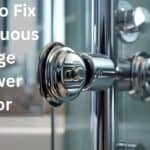
Image capturing the moment when droplets of water, glistening in the soft bathroom light, trickle down the wooden door frame, forming delicate rivulets that merge with a growing puddle on the tiled floor
A sinking feeling washed over me as I stood in the bathroom and noticed water dripping from the door frame. It was a clear sign of a leak somewhere, and I needed to act quickly to prevent further damage.
In this article, I will explore the common causes of water drips, guide you in diagnosing the source of the leak, provide tips for stopping the drips through repairs and prevention, and advise when it’s time to call a professional.
Let’s dive in and solve this problem together.
Key Takeaways
- Condensation, leaky plumbing fixtures, a warped or rotting door frame, or clogged drain holes can cause water dripping from the bathroom door frame.
- To prevent water drips, implement effective moisture control measures, use proper ventilation solutions, install exhaust fans or open windows for air circulation, and utilize dehumidifiers to reduce moisture content.
- Plumbing issues such as leaking faucets, showerheads, or pipes can contribute to water drips from the door frame, so diagnose and address these issues promptly.
- To fix a damaged door frame, it is necessary to repair it with new wood or vinyl material, apply a waterproof sealant, install a drip edge, choose the suitable door frame materials to prevent warping and rotting and ensure the frame’s structural integrity.
Common Causes of Water Drips
I see a few key factors as I examine the common causes of water drips from a bathroom door frame.
Firstly, condensation can accumulate on the door frame due to high humidity levels in the bathroom.
Secondly, leaky plumbing can result in water seeping into the door frame and causing drips.
Lastly, a warped or rotting door frame may allow water to penetrate and drip into the bathroom.
Additionally, clogged drain holes can contribute to water buildup and subsequent drips.
Condensation
One of the most common causes of water drips in the bathroom is when condensation forms on surfaces. Condensation occurs when warm, moist air comes into contact with more excellent surfaces, causing the water vapour in the mood to turn into liquid. This is often seen on bathroom surfaces such as windows, mirrors, and door frames.
To prevent condensation and minimize water drips, implement effective moisture control measures. This can be achieved through proper ventilation solutions, such as installing exhaust fans or opening windows to allow air circulation. Additionally, dehumidifiers can help reduce the moisture content in the air, further preventing condensation.
Leaky plumbing
Two common causes of water drips in the bathroom are leaky plumbing fixtures and pipes, and these issues can lead to significant water damage if not addressed promptly. Diagnosing leaks in the plumbing system is essential to prevent water damage and ensure the proper functioning of the bathroom. Here are some common signs to look out for:
| Common Signs | Possible Issues |
|---|---|
| Dripping faucets | Worn-out or faulty washers |
| Leaking showerheads | Loose connections or damaged seals |
| Water stains on walls or ceilings | Leaking pipes or joints |
| Puddles on the floor | Cracked or damaged pipes |
Regularly inspecting and maintaining the plumbing is crucial to prevent water damage and fix plumbing issues. This may involve tightening connections, replacing worn-out parts, or hiring a professional plumber for more complex repairs. Addressing these problems promptly can avoid costly repairs and ensure a safe and functional bathroom environment.
Warped/rotting door frame
I’ve noticed that a common cause of water drips in the bathroom is a warped or rotting door frame, which can lead to water leakage and potential structural damage. When a door frame becomes warped or rotted, it can no longer provide a tight seal, allowing water to seep.
To address this issue, there are several repair options available.
Firstly, the damaged door frame can be repaired by removing the affected area and replacing it with new wood or vinyl material.
Secondly, moisture prevention measures should be taken, such as applying a waterproof sealant or installing a drip edge to divert water from the door frame.
Lastly, choosing the right door frame materials, such as treated lumber or PVC, can help prevent warping and rotting in the first place.
These steps won’t only stop water drips but also ensure the structural integrity of your bathroom door frame.
Clogged drain holes
There are several common causes of water drips in the bathroom. One of them is clogged drain holes. Moisture can accumulate and leak from the door frame when the drain holes in your bathroom become clogged. This can result from various substances blocking the drain holes, such as hair, soap scum, or mineral deposits.
Maintain the drainage system regularly to clear the blockage and prevent clogs. One way to do this is using a plunger or a drain snake to remove any debris causing the clog. Additionally, using a mixture of vinegar and baking soda can help dissolve any mineral deposits obstructing the drain holes.
Diagnosing the Source of the Leak
To diagnose the source of the leak causing water to drip from the bathroom door frame, there are several key points to consider.
Firstly, assess for condensation, as this can often mimic a leak.
Secondly, checking the plumbing fixtures, such as the showerhead and faucets, is crucial to determine if there are any issues with the water supply.
Additionally, inspecting the door frame for cracks or gaps that may allow water to seep through is necessary.
Lastly, locating and clearing any drain holes in the bathroom floor can help prevent water buildup that may be causing the leak.
Assessing for condensation
During my investigation, I noticed that the water dripping from the bathroom door frame occurs primarily after hot showers. To assess for condensation and identify the source of the leak, I recommend the following steps:
- Monitor humidity levels: Use a hygrometer to measure the moisture in the bathroom. High humidity levels indicate a more significant potential for condensation.
- Check the exhaust fan: Ensure that it is functioning correctly and is being used during and after showers to remove excess moisture from the air.
- Inspect the door frame: Look for any signs of moisture damage or mould growth on the door frame. This can indicate that condensation is forming and causing water to drip.
- Seal gaps and cracks: Seal gaps or cracks around the door frame to prevent warm, moist air from escaping and condensing on the more excellent surfaces.
- Consider insulation: If condensation continues to be an issue, adding insulation to the interior walls can help regulate temperature and reduce the risk of condensation.
Checking plumbing fixtures
After completing the assessment for condensation, I’ll now move on to checking the plumbing fixtures to diagnose the source of the leak.
It’s crucial to thoroughly inspect all plumbing fixtures to identify any leaks or potential issues causing water damage. Start by examining the faucets, showerheads, and toilet connections for any signs of leakage, such as water stains, drips, or puddles.
Check the water supply lines and valves, ensuring they’re tightly secured and free from cracks or corrosion. Additionally, inspect the drains and pipes for any blockages or signs of wear and tear.
Inspecting door frame
I carefully examine the door frame for any visible signs of water damage or potential areas from which the leak may originate. Identify the water sources and prevent future damage.
During my inspection, I look for the following:
- Cracks: I check for any damages in the door frame, as they can allow water to seep through and cause leaks.
- Soft spots: I press on different parts of the frame to identify any weak areas that could indicate water damage.
- Mould: I search for any mould growth signs indicating water leakage.
- Discolouration: I pay attention to any discolouration on the frame, which can suggest previous or ongoing water damage.
- Water stains: I inspect the frame for any visible water stains, which can help pinpoint the leak’s location.
Locating and clearing drain holes
To properly diagnose the source of the leak, I started by locating and clearing the drain holes in the bathroom door frame. These drain holes are essential for allowing water to flow out of the structure and prevent it from seeping into the surrounding area.
To locate the drain holes, I carefully inspect the bottom of the door frame, looking for small openings or slots where water can escape. Once found, I use a small brush or pipe cleaner to clear any blockages that may obstruct the drain holes.
Regularly maintain these drain holes to ensure they remain clear and functional. Preventative measures such as placing a mesh screen over the drain holes can help prevent debris from clogging them. DIY solutions like using vinegar and baking soda mixture can also effectively clear minor blockages.
Stopping the Drips: Repairs and Prevention
Several repairs and preventive measures should be considered to prevent water from dripping into your bathroom door frame.
First, address condensation by ensuring proper ventilation and using a dehumidifier if necessary.
Next, fix any plumbing leaks that may be causing water to seep into the door frame.
Additionally, repair any damage to the door frame, such as cracks or gaps, to prevent water from entering.
Unclogging drain holes and regular preventative maintenance can also help avoid future water leaks.
Addressing condensation
When dealing with water dripping from the bathroom door frame, I’ll start by addressing the condensation issue and taking steps to prevent further damage. To address the problem effectively, the humidity levels in the bathroom. This can be done using a hygrometer, which measures the air’s moisture. Once the humidity levels are determined, steps can be taken to prevent condensation.
Here are some effective methods:
- Ensure proper ventilation in the bathroom by using exhaust fans or opening windows.
- Use a dehumidifier to remove excess moisture from the air.
- Insulate the bathroom door frame to prevent cold surfaces that can lead to condensation.
- Install weatherstripping around the bathroom door to create a seal and prevent air leaks.
- Repair any water damage to the door frame promptly to prevent further issues.
Fixing plumbing leaks
I’ll start by checking for any plumbing leaks to stop the drips and prevent further damage. Assessing water damage is crucial in understanding the extent of the problem.
First, I’ll examine the pipes under the sink, looking for any signs of leakage or loose connections. If I find any leaks, I’ll seal them immediately using the plumber’s tape or pipe sealant.
Next, I’ll inspect the fixtures and seals, such as the faucet and showerhead, to ensure they aren’t causing the leaks. If necessary, I’ll replace any worn-out seals or faulty fixtures.
To prevent future leaks, I’ll advise using a drain strainer to prevent clogs and regularly inspecting the plumbing system for any signs of leakage or corrosion. Also, maintaining proper water pressure and avoiding harsh chemicals can help extend the plumbing system’s lifespan.
Repairing door frames
A common issue with bathroom door frames is small amounts of water dripping from the bottom. It can be fixed by tightening or replacing the door seal. To repair the door frame and prevent further water damage, there are several effective techniques you can try:
- Inspect the door seal: Check for any gaps or signs of wear in the door seal. If necessary, tighten or replace it to create a tight barrier against water leakage.
- Address moisture damage: Examine the door frame for any signs of moisture damage, such as mould or rot. Remove and replace any affected areas to restore the integrity of the structure.
- Consider DIY solutions: Various DIY solutions, such as using waterproof sealants or installing a drip edge, can help prevent water from seeping into the door frame.
- Maintain proper ventilation: Ensure that your bathroom has adequate ventilation, such as exhaust fans, to reduce the amount of moisture in the air and minimize the risk of water damage.
- Regular maintenance: Regularly inspect and maintain your door frame to identify and fix any issues promptly, preventing them from becoming more severe.
Unclogging drain holes
I’ll need to unclog the drain holes to address the water dripping from the bathroom door frame. Opening the drain holes is essential in preventing water buildup and subsequent leaks.
There are several unclogging techniques you can try. One option is to use a pipe cleaner to remove any debris or buildup in the drain holes. Another effective method is to use compressed air to blow out any clogs.
Regular maintenance is key to preventing future clogs. Clean the drain holes regularly to ensure proper water flow. Additionally, installing new drainage systems can help prevent clogs and reduce the risk of water damage.
Preventative maintenance
Regular maintenance prevents water drips and maintains a dry bathroom door frame. To avoid water damage and keep your bathroom door frame in pristine condition, here are some preventative measures to consider:
- Ensure proper bathroom ventilation for adequate air circulation and minimize moisture buildup.
- Install exhaust fans in the bathroom to remove excess moisture and prevent condensation on the door frame.
- Regularly check for leaks or water damage around the bathroom fixtures, such as faucets and showerheads, and repair them promptly.
- Use moisture-absorbing materials, such as dehumidifiers or packs, to control humidity levels in the bathroom.
- Apply a waterproof sealant or paint to the bathroom door frame to create a barrier against moisture penetration.
When to Call a Professional
I recommend contacting a plumber immediately if you notice water dripping from your bathroom door frame. While some plumbing issues can be fixed with a do-it-yourself approach, this particular problem requires the expertise of a professional. Attempting to fix it alone could lead to potential dangers and further damage to your bathroom. Here are a few reasons why calling a professional is the best course of action:
| When to DIY | Potential Dangers | Cost of Professional Help |
|---|---|---|
| Minor leaks or drips | Mold growth and structural damage | Varies depending on the extent of the problem |
| Simple repairs | Electrical hazards | It can be cost-effective in the long run |
| Routine maintenance | Contamination of the water supply | Provides peace of mind and guarantees quality work |
Dripping From Your Bathroom
By promptly addressing the water dripping from your bathroom door frame and seeking professional assistance, you can prevent further damage and ensure the safety of your home.
In conclusion, thoroughly analyse the situation to determine the cause of the water dripping. Once the problem has been identified, you can use the following troubleshooting tips to address the issue effectively:
- Check the door frame for any signs of damage or deterioration.
- Inspect the surrounding areas, such as the shower or bathtub, for leaks or moisture.
- Ensure that the door is sealed correctly and that the weatherstripping is intact.
- Consider installing a drip edge or a waterproof membrane to redirect water away from the door frame.
- Regularly maintain and clean the bathroom to prevent mould or mildew growth.
Could Wall Shaking Cause Water to Drip From Bathroom Door Frame?
If your bathroom door frame is dripping with water, it could be due to the fact that the wall shakes when the door closes. This movement can cause the water to seep through the frame and create the dripping effect. It’s important to address the wall shaking to prevent further damage.
Frequently Asked Questions
How Can I Prevent Water Drips From Occurring in the First Place?
I’d recommend implementing waterproofing techniques and practising moisture control to prevent water drips. By doing so, you can effectively prevent water damage and maintain a dry environment, ensuring the longevity of your bathroom door frame.
Are There Any Temporary Fixes I Can Try Before Calling a Professional?
Before calling a professional about water dripping from the bathroom door frame, I suggest temporary fixes and DIY solutions. Troubleshooting tips may help you address the issue without needing immediate professional help.
Can Water Drips From the Bathroom Door Frame Cause Any Long-Term Damage?
Water dripping from a bathroom door frame can cause long-term damage if not addressed promptly. It is crucial to prevent damage by identifying the source, fixing any plumbing issues, and considering temporary solutions until a professional can be called.
Are Any Specific Tools or Materials I Need to Repair the Water Drips?
To repair water drips from a bathroom door frame, you will need some preparation tools like a screwdriver and a caulking gun. The required materials include silicone caulk and a towel. Repair involves removing old caulk, applying new caulk, and wiping excess.
Is It Possible for the Water Drips to Be a Sign of a More Serious Plumbing Issue in the House?
Water drips from the bathroom door frame could indicate a more severe plumbing issue. Ignoring these drips could lead to water damage, mould growth, and costly repairs.

Hi, I’m George Anderson, an expert installer with an extensive door installation and maintenance background. I’m passionate about sharing my knowledge on door equipment and accessories through my writing, helping homeowners make informed decisions. My specialty lies in custom door installations, with a commitment to enhancing the aesthetics of every home. Please feel free to reach out anytime for help with door-related questions or needs.










